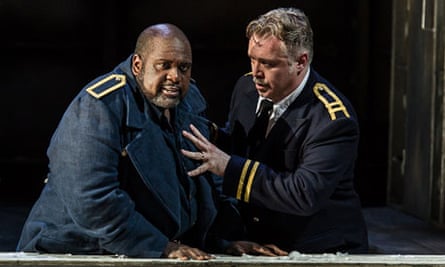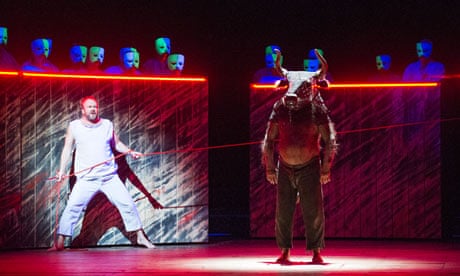Human jealousy and the curse of love. A mythical creature and the absence of love. Verdi's Otello and Harrison Birtwistle's The Minotaur stand in stark contrast, one a drama of circumstance, the other a tragedy of existence. Their musical habitats, too, are as alien as rainforest from tundra: Verdi we see as the genius of traditional lyricism whereas Birtwistle is, we assume, the uncompromising iconoclast who resists the paths of softness.
Assumptions obligingly backfire, as they did last week encountering the two operas side by side – a new Otello at Opera North and a revived Minotaur at Covent Garden. Not to labour the parallels or deviations, the surprise was the degree of overlap. Man teeters on the brink of bestiality in Otello and finally yields, coaxed into the labyrinth of Iago's corrupt mind. In The Minotaur, the torsions and mirrors are more literal – this half-man, half-bull, this "neither-nor" creature is imprisoned in the Cretan labyrinth awaiting his one lonely gratification, the flesh of the Innocents who arrive in a ship with a black sail.
But there's a more potent link. Both works have melody at their heart, Desdemona weaving her song through the storms and eruptions of Otello to the quiet simplicity of her Willow Song, Ariadne – via the sleazy, smoky colours of an alto saxophone – entwining hers in the labyrinth of Birtwistle's music and leading us through. Ariadne has the harder task: if you sit back in Verdi, and I am not recommending that you do, the musical shapes and patterns still seem familiar.
That option isn't there in Birtwistle. You cannot be a bystander. The inexorable pace of this monolithic score, in fact consisting of constant, bright threads of melody rising up from low woodwind to sinewy high strings, and splashed with every kind of sensuous percussion from temple blocks and bongos to harp and cimbalom, will crush you if you don't listen and overwhelm you in the best sense if you do.
First, the new production: Opera North have put down an early marker in Verdi's 200th birthday year with an updated Otello by Tim Albery, superbly conducted by Richard Farnes. The greatest achievement came from the orchestra, who gave fresh focus to the sonic inventions of Verdi's penultimate score: the elaborate string ornaments and burbling, fermenting woodwind which would later be used, to comic instead of menacing effect, in his last work, Falstaff.

As a staging, this co-production with Scottish Opera, supported by the Peter Moores Foundation, plays it safe. Albery concentrates on strong storytelling, without extraneous ideas or controversy beyond a workable transfer from Shakespeare's Cyprus to a US naval base c1942. Venetians against Turks, Americans against fascists, war is war. The crowd scenes are powerful, the chorus on fine form, and the sense of musical and dramatic layering – Otello standing aloft and eavesdropping, as Iago intends – well conveyed. Leslie Travers's designs make generic beauty out of the drab oppression of battle: girders and walkways, pools of low light (lighting by Thomas C Hase), peaked caps and big overcoats, with Otello (Ronald Samm), massive and at first heroic, wearing the biggest and most capacious topcoat of all.
David Kempster, an Iago with physical presence as well as real vocal assurance, bolstered the otherwise uneven cast. He precisely fits the description laid down by Verdi's librettist, Boito, when describing character traits: "[Iago] must be handsome and appear jovial and open and almost good-natured". This made the dilemma of his wife Emilia (Ann Taylor), torn apart by fear and duty, all the more credible. She knows that her husband is mere "primordial slime" yet she cannot resist him.
Neither Samm's Otello nor Elena Kelessidi's Desdemona, both performances eliciting sympathy and compassion, hit the mark vocally. The cruel demands of the title role make this opera particularly hard to cast. But better to have Samm's convincing performance than a more vocally dazzling alternative. Away from first-night nerves, his voice will surely settle and blossom. The same may be true of Kelessidi, who after a slightly inhibited start thawed as the evening progressed. Catch it on tour.
First performed in 2008, Stephen Langridge's exemplary production of The Minotaur returned, with mostly the same cast and greater clarity and force. Alison Chitty's bullring-inspired designs, opening with video of a slow-churning black sea which also accompanies the orchestral interludes, called toccatas, retains its raw grandeur. Masked crowds, pinioned harpies – led by Elisabeth Meister – and a snake priestess on stilts (Andrew Watts) stamp their indelible mark on Birtwistle's mythical landscape, a place of fear and beauty.
The same trio of lead soloists – Christine Rice (Ariadne), Johan Reuter (Theseus) and John Tomlinson in the title role – are back to give phenomenal performances. Rice, almost constantly on stage, unnerving as quasi-narrator and lustful protagonist, was both terrific and terrifying. After the slow-burn opening, the music jolts into lurching, syncopated life as she relates how her mother succumbs to the white sea-bull and gives birth to Asterios ("Starry"), the Minotaur.
David Harsent's libretto, especially here, is masterly in its use of visceral and bony imagery. The birth pangs of labour, the call for herbs to hasten it, and that first horrific appearance of the newborn's black muzzle and buds of horns is as unsettling as any moment in opera. The ROH orchestra, dominated by an army of bass and contrabass instruments, played with rigour and finesse for the conductor Ryan Wigglesworth, in his ROH debut. He took over from Antonio Pappano, who is currently suffering from conductor's elbow. In warm consolation, earlier in the evening he was presented with an ISM distinguished musician award.
In turn, at the end Pappano came on stage to celebrate John Tomlinson's 35 years at the Royal Opera House. "You're a monster," Pappano quipped, presenting him with a huge, sugary creation on a trolley. Tomlinson, still in bloodied Minotaur garb and wielding a big knife, yet beguiling as ever, was well and truly the icing on his own epic cake.

Comments (…)
Sign in or create your Guardian account to join the discussion